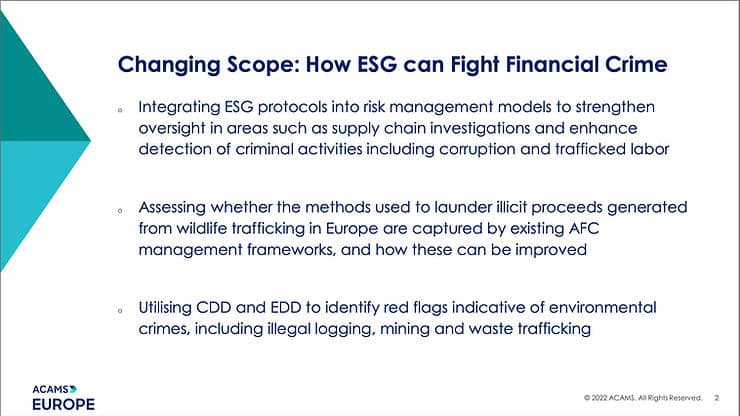One of the highlights of ACAMS Europe this month was the panel Changing Scope: How ESG can Fight Financial Crime. This was an exciting discussion between the panellists:
Here were our four key takeaways:
1. ESG Regulation is coming and companies feel unprepared.
The reputational risks of poor ESG standards are now established. Whether from investors, employees, or customers, companies are facing pressure from all angles to uphold strong values across the ESG spectrum.
But as David Clark pointed out, ESG compliance is no longer a nice to have. It is a requirement. It is now a regulatory risk, as well as a reputational one. FATF has admitted to past oversights and is now making ESG a focus.
More regulation is coming around suppliers. Mandatory human rights regulation is coming in in the EU. In the U.K. there are new regulations around working with organisations involved in deforestation.
Early on in the session, the panel ran a poll ‘To what extent is ESG factored into your FI’s CDD process?’. Unsurprisingly, most FIs are just getting started.
2. ESG and financial crime are two sides of the same (KYC) coin.
Alexandria Reid described how increased regulation and changing public sentiment were converging to pile massive pressure on corporates to manage their ESG risks.But most companies feel unprepared for this change. Whole new departments and roles are being created to handle ESG issues.
This isn’t the best answer – in terms of companies’ bottom lines or ESG realities on the ground.
3. Knee-jerk solutions risk massive resource wastage
Major investment is going in to ESG risk management and new job roles are rapidly being created to cope with this new pressure. But there is a major risk of duplication with anti-financial crime (AFC) roles. Knowing and managing your ESG risk exposure comes down to having a deep understanding of the customer – an age old story in the fincrime community.
Michael Zammert said that as with financial crime, the risk assessment is the most important process. Companies must avoid double counting risks. Really, the KYC process is the same for corporates looking for supply chain loans, as for retail customers. It is the same set of questions: who are you, what do you do, where are you located. AKA, client , product and geographical risks.
Even the risks are similar – Alexandria Reid explained how ESG crimes are associated with money laundering & tax evasion – the bread and butter of the fincrime community.
4. The solution – one consolidated process
If KYC is the key to both ESG and financial crime risk mitigation, and the same or similar questions apply to each then having one standardised KYC process is the obvious solution. This could save companies millions in money and time in developing and implementing whole new systems and processes.
What does combining AML and ESG KYC look like in reality?
It can be as simple as adding ESG relevant terms in to existing risk assessments. This most obvious area this affects is adverse media screening.
Xapien is a simple-to-use AI platform that delivers fully-automated background reports on any individual or organisation in minutes.
In a few minutes, Xapien will deliver a fully-referenced, shareable report that analyses all open-source media, as well as structured data, to flag ESG as well as traditional AML risks.
Book a demo with one of our team now to find out more.



